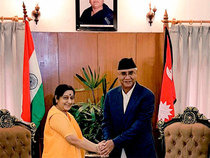 By Bishnu Hari Nepal (23 August 2017) – In the fiscal year of 2016-2017, Nepal’s imports from India were worth US$ 6.6 billion, which is around 70 percent of Nepal’s total imports. Due to the “inhuman Indian economic embargo” against Nepal in 2015 (right after the devastating earthquake), the imports from India to Nepal declined to some extent.
By Bishnu Hari Nepal (23 August 2017) – In the fiscal year of 2016-2017, Nepal’s imports from India were worth US$ 6.6 billion, which is around 70 percent of Nepal’s total imports. Due to the “inhuman Indian economic embargo” against Nepal in 2015 (right after the devastating earthquake), the imports from India to Nepal declined to some extent.
Yet still India occupies 63 percent of the Nepalese market. Contrary to it, Nepal’s exports to India during the fiscal year of 2016/17 was worth only US$660 million. This, for LLDC Nepal, was 60 percent of the country’s exports.
In the last ten months of the fiscal year of 2016-17, Nepal’s foreign trade increased by 30.7 percent and out of Nepal’s US$10 billion trade volume, only US$3 billion of it was with other countries apart from India.
The tragedies from the past to the present
Nepal is not only a land-locked developing country, but she is more or less, an “India- locked” country.
During British rule, Nepal didn’t allow the trade-route via her soil planned by the East-India-Company to exploit then Tibet. As a result, post 1811 Nepal faced the “first” Indian economic blockade.
Later, the Anglo-Nepalese War of 1814-1816 broke out. Then Nepal was compelled to sign the infamous Treaty of Sugauli with British-India. Nepal lost one-third of her soil in this Treaty. Today, Nepal has a 1780 km long open-border with India on her three sides: south, east and the west. This is a privilege for Indians to dominate Nepal’s exports and imports, legally or illegally.
In terms of fair trade, the Indo-Nepal open border has proved to be a curse to Nepal. It has been a haven for India for massive illegal trade as well as political infiltration to Nepal.
The force of India’s 1.3 billion population compared to Nepal’s 28.4 million people means huge pressure on Nepal. When Nepal signed three new treaties with China in 1956, 1960 and 1963, Nehru was upset with Nepal.
He even gave pressure to King Mahendra not to construct the Kodari High Way –opening the door for trade with China. The scenario post the Sino-Indian War of 1962, the construction of Kodari High Way in 1967 and expulsion of “Indian Security Network” from the northern border points of Nepal – adjoining to China in 1969 – made India nervous against her monopolistic third largest-trade market Nepal.
Despite signing an arms agreement with Nepal in 1965, India again plotted an “Economic Embargo” in 1969-70, when Nepal was a non-Permanent Member in the UN Security Council. It is well known to the world that Nepal suffered the longest “Economic Blockade” again in 1989 when she bought cheaper weapons from China in 1988. Therefore, trade and transit rights of Nepal are always curtailed by India in the name of the “Big Brother” of Nepal!
Even though Nepal deserves fundamental transit rights from India, being a member of the WTO, SAARC, LDC, LLDC, BIMSTEC, UN, etc., trade and transit regulations are performed by bilateral agreements only.
The South Asian Free Trade Area (SAFTA) agreement came into force in 2006, but India, due to conflict with Pakistan, even threatened the survival of South Asian Association for Regional Cooperation (SAARC) itself. Similarly, the BFTA-BIMSTEC-Free-Trade-Area passed as a framework agreement in 2004, was also challenged by India due to disagreements with Thailand. Thus, countries like Nepal are compelled to remain under such hegemonic apprehensions from the past and until the “inhuman economic embargo” of 2015.
Nepal’s most important products for exports are: hydropower (83,000MW), water (second largest after Brazil) and minerals, which are all curtailed by India under the Koshi Agreement (1954), Gandak Agreement (1959), Mahakali (now Pancheswore after Modi came to power) Treaty (1996).
Every year Nepal’s Terai is flooded and half of Nepal’s population, fertile land and products are affected due to India’s dams in 39 locations and the 1700 km road to the Indian side blocking floods adjoining the Nepal border.
BRI: the only hope for Nepal
Due to lack of proper connectivity and development of infrastructure on the Nepal side, Nepal’s trade volume with China is only 14 percent of the $10 billion.
Under BRI, China has agreed to provide US$8.3 billion for Nepal’s all-round development and another US$8 billion for joining up the Kerung/Gyrung-Kathmandu-Pokhara-Lumbini Him Rail.
This is huge money for Nepal in comparison to India’s US$317 million and America’s $500 million investment. During Vice Premier Wang Yang’s recent Nepal visit, RMB1 billion was announced to repair the Kodari High Way and an additional commitment to construct roads in the Nepal side joining seven points on the1400 km long Nepal-China border.
This BRI trajectory helps tremendously to promote Nepal/South Asia-China trade, tourism, transportation, transfer of technology, FDI and hydropower/energy generation.
Dr. Bishnu Hari Nepal is a theorist and practitioner in international relations, peace, conflict, security and development studies. This article was originally posted on china.org.cn

